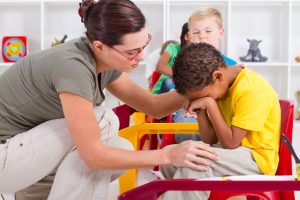Teacher Self Care: 5 Strategies for Giving Yourself Time to Recoup… So You’re Able to Give More of Yourself
3/2/2021

Have you heard of the saying, "Covid Fatigue?"
Imagine a classroom full of students with bright eyes and happy faces. All the students are dancing in the classroom and singing a song about obtuse, acute, right, and straight angles. Their arms stretched out matching the type of triangle in which they sing as they continue to dance, around and around. As an observer of this classroom, I believe there is nothing that brings me more joy in education. I found my own eyes lighting up, as I began to smile as well. I miss this carefree feeling!
Not only during the pandemic, but educators have always been tasked with making sure our students and staff are safe. Safety is first and foremost on our minds. The difficult part during the pandemic is the percentage of our brain that is used to process this need for safety...it has increased substantially.
After the 2012 Sandy Hook school shooting, I remember as an elementary principal adding in new safety procedures and protocols to keep students and staff safe. I walked the hallways after students entered the building every morning, checking each and every single outside door to make sure it was locked. We even added in a locked door buzzer system for visitors, required name badges for all employees, established a sign in procedure for all visitors, and required all staff receive Armed Intruder Training, to name just a few items we implemented after this horrid school shooting.
Safety during this pandemic obviously looks much different from the protocols and procedures we added after Sandy Hook. The difference, for the most part, is after these safety protocols were established, we as educators could all get back to teaching and having fun with our students.
I am not here to debate which protocols and procedures are more important, I am writing to describe the difference in most educators' brains before they can even get to "teaching."
During the pandemic, with face-to-face learning, we are constantly checking to see if students' temperatures are under 100.4 degrees, everyone is wearing their masks correctly (even our colleagues), and that students are all socially distanced as best as we can manage (and that we are also distanced from students and from our colleagues in all situations). And, of course, you better believe those high touch surfaces are clean and sanitized routinely, both in our classrooms and in other places within our school. Then...we can teach.
For those educators who are still teaching remotely and not face-to-face with students, there are a plethora of new processes they must think about continually, as well. Remote teachers are verifying whether students have devices and adequate internet connectivity, that they are able to log on at a specific time for synchronous learning, and that they are submitting the work they complete asynchronously (and that it's done correctly). We are constantly worried about whether our students are getting their needs met at home, especially social and emotional needs. When all that is done…. Then we can teach.
This new normal is causing "Covid Fatigue." How much would we like to get back to normal? I keep reminding myself, "We will soon, safety of all students and staff must come first!" In the meantime, here are five strategies to make this pandemic more manageable for educators.
1 - Show Compassion to Everyone

As educators, when our plates are full it can be difficult to deal with people when they are upset, angry, or rude, even if it is our parents, community members, and students. We hold back words we want to say that are running through our heads. This restraint helps us take the higher road in many of these stressful situations. We can reframe these situations and mis-directed stress from others by continually reminding ourselves, "Even though they are upset, and they are taking their frustration out on me, it is not personal." As educators, we have close relationships with our parents and students.
The more we can continue to show compassion to people who are frustrated, the more we will not feed into this unintentional frustration and anger. We can continue to model how people should be treated with respect, always listening first before reacting, and then acting with kindness and compassion.
Putting yourself into someone else's shoes can be physically and emotionally draining. In order for us to transcend the negativity, we must address it, and reframe it. We need to be careful to not reframe it to the positive without addressing the underlying issue. This can be toxic. In fact, there has been many recent publications during the pandemic on the idea of toxic positivity.
"Toxic positivity is the belief that no matter how dire or difficult a situation is, people should maintain a positive mindset. It's a "good vibes only" approach to life. And while there are benefits to being an optimist and engaging in positive thinking, toxic positivity instead rejects difficult emotions in favor of a cheerful, often falsely positive, facade."
Showing compassion doesn't mean reframing situations with toxic positivity, it means being kind and acting with empathy. When we show compassion, we better understand the realities that someone else may be going through. We can then support them.
2 - Take Time For Yourself

Society may argue that educators only work nine months out of the year, but this couldn't be farther from the truth. Research has shown that educators actually work more hours in the nine months in session with students than a typical 8-5 job all year around. Understanding that, the amount of hours we spend supporting students during the nine months can be overwhelming. Taking time for yourself may sometimes be put on the back burner, and as educators we tend to prioritize everyone else before ourselves.
We must find time to take care of ourselves. This may look like scheduling time to exercise, much like we make an appointment for IEP meetings. We can spend time grocery shopping in order to get better food to eat, rather than continuing to eat out or even relying on fast food. If we are religious, this means taking time to make it to church or a bible study group. Some days, something as small as allowing for time during your day to make a couple phone calls to get bills paid seems impossible. We must take this time for ourselves, though. If we let these necessary tasks slide, they gradually build up and we find we're unable to make the time to give support to others.
3 - The More You Give Yourself, the More You Can Give Others

Taking strategy number two above a step further, is a concept from the High Trust Philosophy. Dennis McLaughlin states, "The more we give ourselves, the more we can give to others." This concept sounds selfish, but in reality, if we truly believe in servant leadership this strategy can be powerful.
To understand this strategy better, let's use the scenario of giving yourself a small trip. This trip may provide time away from the mundane tasks of life at home and work. While going on this trip you are able to recharge, enjoy yourself, and reflect on the great opportunities you have been given in life. This gives you energy, and this energy can then be transferred back into supporting others. This process is a continual cycle.
The opposite of this continual cycle is to continue to put yourself last, working more and more each day until you are bitter with others and yourself. This is exactly where we don't want to be in our lives.
Giving yourself what may be an indulgence, an extra hour exercising, a delightful date with your partner, one more hour of water skiing on the lake, can in turn create a stronger passion for what you do and what you love, as well as invigorating you to give more.
4 - Connecting with Friends, Family, and Community

I have found moving to a new location during this pandemic has been difficult when creating new friends, traveling to see family, and getting out into the community. Though we are using technology to connect us more than any other year in history, the human connection of face to face interaction is what I am craving the most. As I read more stories like this across the nation, we must understand that our social and emotional health is vital to our overall happiness and success.
Now more than ever, we need to connect with friends, family, and get out in our communities, but do so safely. This may mean continuing to use social media and technology to communicate, or may mean actually laying your eyes on someone and hearing their voice. I believe this can be done safely. Recently, I visited my parents through a screen door. We were all wearing masks...driving four hours just to celebrate my dad's ninetieth birthday was worth it. After two months of not seeing my parents face to face, this is exactly what I needed.
We are social beings and shutting ourselves off to friends, family and community can have lasting consequences for all our relationships, and especially our own social and emotional health. We need to continue to find ways to connect with people all around us.
5 - Supporting Others

Finding others to support us is vital to our health. Many of us get support from our circle of colleagues, friends, and loved ones. This support may look different for every person and always change depending on the time in our lives. We continually find new people to add into our circle, we may even create new circles, as we try to meet our needs for human connection.
In much the same way, we can and should support others. The ability to serve others can give us the much needed feeling of humbleness and kindness. When we give our time, our money, and anything else to those who need it, we in turn are modeling what we would like when we need support. Whether you are an introvert or extrovert, human connection and supporting others is in our DNA.
In education we find ourselves supporting students, families, and organizations in our communities. When our cup is full, we then go back to getting support for ourselves, then in turn we can give again. This constant cycle of giving and receiving support helps us create long lasting relationships. Many educators give without ever expecting anything in return.
Finding ways to support virtually has been challenging, but it is doable. Thinking about ways we can give support through our words and actions can be time consuming. The more we give, the more we can give ourselves.
I encourage you to put one or more of these strategies in place. What strategy will you start with and why did you choose that strategy? I would love to hear from you...let's fill each other's cups!
- Learning How to Say No and Set Boundaries with Parents - November 21, 2022
- If You Had Only One Behavior Strategy to Use in Your Classroom, What Would It Be? - September 26, 2022
- Live Your Code: 7 Strategies That Will Help You Be the Most Effective Educator You Can Be - August 15, 2022











